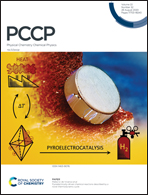How charge regulation and ion–surface affinity affect the differential capacitance of an electrical double layer
Abstract
The differential capacitance of an electrical double layer is a topic of great importance to develop more efficient and environment-friendly energy storage devices: electric double layer supercapacitors. In addition to the bare electrostatic interactions, recent experimental and computational studies suggest that electrodes covered by ionizable groups do interact selectively with specific ion types, an effect that can increase the maximal conductivity and voltage of a supercapacitor. Inspired by this, in the present work we investigate how ion-specific non-electrostatic interactions modify the differential capacitance of a flat electrode whose surface is covered by ionizable groups subject to a charge regulation process. The incorporation of hydration interactions by means of ion-specific Yukawa potential into the Poisson–Boltzmann theory allows our model to describe different scenarios of ion–surface affinity and, hence, the selective depletion or accumulation of specific ion types close to a charged surface. We obtained larger capacitance values when considering electrodes that favor the accumulation of cations and the depletion of anions.



 Please wait while we load your content...
Please wait while we load your content...